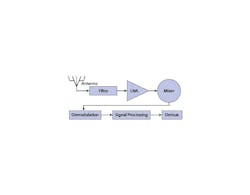RF Design Made Simple
RF/microwave technologies are penetrating virtually every industry. The use of these technologies as tools, or for telecommunications purposes, is a growing trend worldwide. However, knowledge of fundamental and practical aspects of RF design is widely lacking in most industries. To help aid in providing the basics to those new to RF/microwave systems, Rohde & Schwarz prepared a white paper sharing the system level fundamentals of common RF technologies.
The basics of an RF communication system involve taking information, processing it, and transporting it over a RF medium to information processing systems at the information destination. This requires the ability to input information electrically and convert that information to an RF signal for propagation. Additionally, that signal will have to be received, processed, and converted into usable information.
Electromagnetic energy in the RF spectrum is used to transport information over long distances or at high data rates. Different standards, frequencies, and methods of transporting the data over an RF signal are used for a variety of different applications and industries. The basics components necessary for this process are transmitters, receivers, and antennas. True to their names, transmitters send data out through carrier RF signals, were receivers take that previously transmitted data and convert it to useful electrical signals. Antennas are the coupling mechanisms that enable RF energy to be sent in a controllable fashion over the “air.”
Transmitters, receivers, and antenna are constructed of conductive/metallic components, as well as filters, amplifiers, frequency mixers, and modulators/demodulators. Filters block out certain signals from traveling further along the signal chain, where amplifiers increase the signal energy for either transmission or signal processing. Frequency mixers are used to shift the information carried in an electrical or RF signals to different frequency regimes. Modulators and demodulators convert electrical signal information into a format that is more readily transmitted and received over an RF signal path.
The operation of these devices needs to be confirmed and verified. Test and measurement, or metrology, equipment is used to analyze the behavior of RF/microwave devices. For measuring unknown power signals, signal/spectrum analyzers are used. In order to provide a known test signal, a signal generator is employed. When an unknown systems frequency response needs to be illuminated, vector network analyzers detail system/component behavior. If a simple power measurement is needed, power meters/sensors are viable options.
Rohde & Schwarz, 6821 Benjamin Franklin Dr., Columbia, MD 21046, (410) 910-7800
About the Author
Jean-Jacques DeLisle
Jean-Jacques graduated from the Rochester Institute of Technology, where he completed his Master of Science in Electrical Engineering. In his studies, Jean-Jacques focused on Control Systems Design, Mixed-Signal IC Design, and RF Design. His research focus was in smart-sensor platform design for RF connector applications for the telecommunications industry. During his research, Jean-Jacques developed a passion for the field of RF/microwaves and expanded his knowledge by doing R&D for the telecommunications industry.
